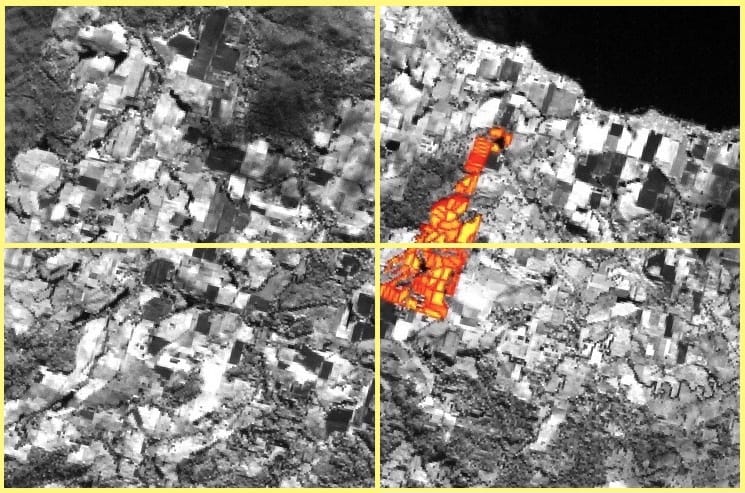We've had a bit of interest on whether we're the new Pastures from Space. You might be more familiar with the acronym PfS+. You could say we're replacing Pastures from Space's position with our entry into the market place at the time they closed their doors. The short answer is no; we're not the replacement for Pastures in Space. However, we do offer a replacement platform should you be left high and dry looking for an app to assess your pasture covers and growth rates.
You may have noticed that our pricing is much higher than that of Pastures from Space. Our pricing is fair in comparison for a good reason, which I'll explain in more detail. First, let's take a look at the satellite tech for a quick comparison.
Pastures from Space used the MODIS system for reporting on pasture growth and cover. This instrument has the following characteristics.
Pixel Resolution:
First of the rank is pixel size, which for this satellite comes in at three resolutions 250m, 500m, and 1000m. Yes, these are huge paddocks! MODIS does have its place, just not in measuring pasture.
Image Frequency:
The revisitation frequency for MODIS is 1 to 2 days.
Image Cost:
MODIS is free for anyone to use.
In recent years, before Pastures from Space closed their doors, they started utilising imagery from the Landsat 8 satellite. This satellite was not used in the PfS+ pasture cover and growth rate models, but for visual analysis only. This instrument has the following characteristics.
Pixel Resolution:
The pixel size used in PFS+ visual reporting was a 30m resolution. These are still big paddocks or very few pixels in a paddock. The recommended number of plate meter readings to take across a paddock is about 40. To get 40 points of measure in a paddock, you need a 40 * 30m = 1,200 square metre paddock. Think this is big, do the maths on the MODIS numbers!
Image Frequency:
Okay, so you think the resolution has indeed shrunk from MODIS to Landsat 8, but get this. The rate at which the Landsat 8 satellite revisits the earth is every 16 days. This revisitation rate is when rain without clouds would be just fine!
Image Cost:
Like MODIS, Landsat 8 is free for anyone to use.
Okay, so what does all this mean?
Well, both MODIS and Landsat are significant initiatives for capturing much data about our dear earth. However, when it comes to pasture, we require something with a bit more jazz, something with a bit more definition, something with a bit of flare. Okay, I'm getting carried away here. Read on to see what our sats' details are.
Pasture.io utilises the PlanetScope constellation that is made up of close to 150 satellites orbiting the earth in a sun-synchronous manner. The time they cross our customers' farms generally between the hours of 9:30 am and 11:30 pm give or take an hour depending on - you guessed it, location and daylight savings. Now to get into some details about these satellites.
Pixel Resolution:
The PlanetScope satellites deliver stellar pixel resolution near 3m. This pixel is one-tenth the size of the Landsat 8 resolution. Quick maths calculates a 120 square meters of the paddock will yield a similar amount of plonks as plate meter could deliver forty times. This calculation means we can measure paddocks with reasonable confidence at a size of about 0.012 hectares.
Image Frequency:
The sheer number of satellites is beneficial for a lower orbit and allowing a daily chance of capturing an image over your farm. This revisitation rate is similar to MODIS with the clincher being a fraction of the pixel size.
Image Cost:
Unlike the MODIS and Landsat imagery, the PlanetScope imagery isn't free. We pay for this imagery. This last bit is a high cost for our company. However, we want to deliver the best remote pasture measuring that yields the best on-farm outcomes. To do this is with imagery that is frequent enough to overcome cloudy days and has a resolution fine enough to understand pasture growth truly.
Don't get me wrong. Pastures from Space had its place in the low rainfall sheep belts where pasture biomass is generally flat and plant density sparse. This reason is partly due to the large expansive areas and the nature of how NDVI works (another day to explain the nature of NDVI) in these regions. In saying the above, this post clarifies our position as a company and one of our differentiators to PfS+. So, as noted above, the short answer is no, we're not a Pastures from Space replacement.
If you're a former PfS+ customer, we'd love to hear your experiences in the comments below.
Happy farming!
- The Dedicated Team of Pasture.io, 2019-07-17
